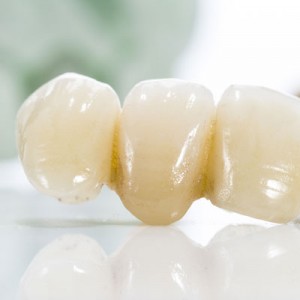Crowns and Bridges
to Fix Severely Decayed Teeth

If a tooth’s surface becomes too badly damaged and a filling or other dental service cannot be done, then a crown (also called a cap) may be a good solution if the tooth’s roots are still strong. The crown may be cemented on top of the old tooth, and will be sized and shaped accordingly.
? When are dental crowns used?
If a tooth is too damaged for a filling, badly broken or cracked, or badly worn down, a crown may be necessary. In the case of a filling, sometimes there is too much damage to the tooth structure in which a filling will not securely adhere to. Also, instead of pulling out a damaged tooth, we can use a crown to rebuild the tooth to its original shape and size.
At Washington Smiles, we save as much of the natural tooth structure as possible. This allows us to place a secure, natural-looking crown on top of the natural tooth.
Types of dental crowns
Crowns can be made of different types of materials. Actually, there are three types commonly used:
- Gold crowns— Gold requires the least amount of preparation of the existing tooth, which allows us to keep the most amount of natural tooth structure when compared to other types of crowns. Gold crowns will not chip and most likely will not cause wear on other teeth. The gold material is extremely workable and allows a secure fit between the crown and the existing tooth. Some people, however, may not like its distinctive appearance.
- All porcelain or all ceramic crowns— All porcelain or all ceramic crowns are very natural looking, and are often used on the front teeth. Sometimes the dentist may need to significantly prepare the tooth (which leaves less of the existing tooth), too. However, this is a popular choice for dental crowns.
- Porcelain-over-metal crowns— Porcelain-over-metal crowns balance great esthetics and durability. They are natural looking and are fused to a metal base, allowing an exceptionally durable and strong bond. With this type of crown, however, a thin, black line might appear where the crown meets the gum (because of the metal underneath).
? What can you expect from the crowns procedure?
The procedure and steps depend on each patient’s case. For instance, if a tooth is extremely damaged, a root canal may be performed first. Otherwise, we will prepare the tooth by filing it down to ensure a proper fit of the crown on top of the tooth and between the adjacent teeth.
Impressions are taken and they are used as a model to create the new crown. The lab typically takes two weeks to prepare the new, permanent crown. In the meantime, you will wear a temporary crown. During your second visit, the temporary crown will be removed and the new crown will be permanently cemented into place. With proper care, crowns can last from ten to fifteen years, or longer.
? What are dental bridges?
If a tooth is missing (not just damaged), a crown can be used as an anchor on adjacent teeth with a false tooth attached to “bridge” the gap. The bridge is a false tooth (called a pontic) that becomes fused to one or two crowns. The pontic is held in place on the gum with the help of anchoring crowns.
Types of dental bridges
- Traditional fixed bridge— A traditional fixed bridge is a false tooth that is fused to two crowns. This technique is similar to a regular crown procedure. It offers the most natural fit and a natural appearance.
- Cantilever bridge— A cantilever bridge is a false tooth that is anchored to a tooth or teeth on one side (and not the other). This technique is similar to a regular crown procedure. It does not have the same strength as a traditional fixed bridge. It can only be used in areas of less stress (the front teeth).
- Removable bridge— A removable bridge is not permanently cemented into place. It may cost less than other options, but will also require extra hygiene attention.
A partial denture is one alternative to a dental bridge. This is a removable appliance that can replace one or more teeth. Another alternative to a dental bridge is a dental implant, which is a permanent solution for missing teeth.
Crowns and bridges from Washington Smiles
If you are interested in learning more about crowns and bridges, or if you’d like to find out if they can fix your dental problems, call Washington Smiles today. We can schedule your consultation appointment right away.